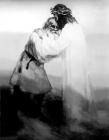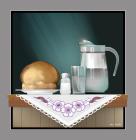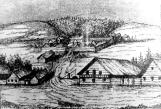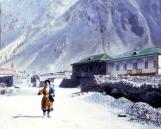1
The Doukhobors of Canada (Preface:)On the onset it should be understood that the Doukhobors of Canada were in fact a few factions - the Independents, the Sons of Freedom, and the larger, Community Doukhobors belonging to a communal enterprise. (There were even Doukhobor Groups in Russia, and some in America as a result of the migration to Canada).
However, while we'd like to be as complete as possible, because the Doukhobor Village Museum (the provider of this exhibit) is representative of the era of the communal villages located at one time in BC, it is only apt that while recognizing all factions, this project focuses more on the Community Doukhobors rather than delving in depth into the politics or workings of other groups.
We mean no disrespect by not including these factions' history after 1939, but wish only to provide background to the Doukhobors of Canada, their communal way of life, the demise of the community, and the subsequent reasons why the Doukhobor Village Museum came to be.
3
Origins:It has been said that the Doukhobors, with roots in Russia, were a social movement and a rebellious religious sect. However, both the Russian Orthodox Church and the Tsarist government recognized this group as fanatics, dissidents, and traitors to the motherland.
Whatever has been said through the years about this relatively small group, proportionately, they have received more publicity than perhaps any other sect of its size - both positive and negative. And one thing can be stated in certainty, much of what has been written and reported about these controversial people has been continually distorted from the truth (by both the press and even some Doukhobor historians). But to understand the Doukhobors of Canada, one needs to understand their background and origin.
4
Little is known of the early Doukhobors in Russia; writings of the phenomena of this group of radicals were recorded in the 1700's though it is thought their beginnings started well before that. It is known that before 1785 they were identified as 'Ikono-bortsi' or Icon-Wrestlers. They rejected icons, wooden or golden crosses or images, as holy. Further, they rejected the idea of priests, the church, and all ritual and mysticism, as well as all of the sacraments such as confession and baptism.Baptism was by the spirit, confession was to brethren, the Eucharist was the meditation on the words of Christ. The miracles of the Bible were symbolic parables, the resurrection of Christ was a spiritual resurrection in the hearts of the believers. To these people, the spirit of God lived equally in all men and women and they rejected the ideas of the Russian Orthodox Church - surmising that the Church and State were incompatibly entwined - and equally corrupt. In Tsarist Russia, this may have in fact been true.
5
Wrestling Spirits: Artist unknown1785
Russia
 Credits:
Credits:From the Autochrome Exhibit, Doukhobor Village Museum, Castlegar, BC
6
In 1785, Archbishop Ambrosius of the Russian Orthodox Church referred to this growing group of Russian religious dissidents as Doukho-bortsi. The term means "Spirit Wrestlers" and he intended it as a derogatory label suggesting that these dissidents were struggling against the Spirit of God and the holy mother church.They embraced the name, saying: "We are Spirit Wrestlers because we wrestle with and for the Spirit of God against those things which are evil". In struggling for a better life they would use only the spiritual power of love rather than any form of violence, noting the scriptural admonishment: Resist not evil. Along with their clash with the Russian Orthodox Church, the Doukhobors heartily believed in the commandment "Thou Shalt Not Kill" and their ardent belief caused a problem for Tsarist Russia, which was inclined to conscript every healthy Russian male of age into her army. Their edict was that if the spirit of God lies within each of us, to kill another human being would be to kill the spirit of God. War was simply incompatible with their Christian beliefs.
8
The Turbulent YearsFrom their early beginnings, the Doukhobors suffered the wrath of priest after priest, bishop after bishop, and tsar after tsar (though some tsars were found to be more liberal or more tolerant than others). In some periods of Russian history, to be found a Doukhobor would mean an immediate life imprisonment of hard labour. Mass trials of Doukhobors who held firm in their beliefs to not bear arms were common in the latter 1700s. In 1802, Tsar Alexander I (one of the more tolerant Tsars) decreed that Doukhobors were to be driven from their lands of the more 'central' locations of Russia, to the Milky Waters region.
10
Pressure on the Doukhobors began almost immediately after Tsar Nicholas took power. While Tsar Alexander's attitude was more or less to leave this non-violent sect alone, Tsar Nicholas had a non-tolerant policy and in the coming years, Doukhobors were banished from the Milky Waters region, leaving behind once again, their hard worked lands.By 1841 all Doukhobors who would not return to the Orthodox Church would lose their homes and lands. By 1845, more than 4,000 Doukhobors were forced to leave their cultivated and prosperous lands for the higher altitude and harsher climate of the Caucasus. Within half a century, and because some Doukhobors had been released from exile or prison, the population of Doukhobors in the Caucuses was said to have grown to around 20,000.
12
While this group rejected organized religion, rejected the priesthood, and rejected rule by authority, it is ironic that throughout their existence the Doukhobors would continually embrace a ?spiritual leader' - one who would speak to and for all Doukhobors. The names Pobirokhin, Kolesnikov, Kapustin, and Kalmykov all ring a bell in the minds of Doukhobor historians, as they represent the names of various early Doukhobor leaders.The latter, Peter Kalmykov, reigned as spiritual leader from 1856 to 1864 when he died from an intestinal infection. On his death bed, he requested that his wife, Lukeria Kalmykova become the uncontested Doukhobor spiritual leader. Her tenure as leader came to be known as the Doukhobors' 'Golden Years'.



